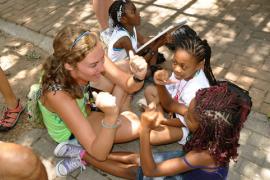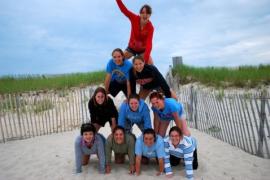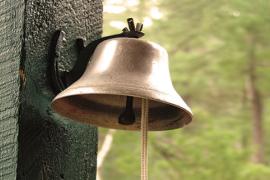We are lucky to be at camp, in the modern world, and not living in a jungle where each new thing might kill us. The fight or flight response comes from ancient times when a person encountered a unique threat — like a tiger — and the brain needed to make a snap decision. Will I run (flight) or will I fight? While most of us do not encounter tigers on a regular basis, we are constantly exposed to new or novel things. These could be ideas, people, situations, food . . . the list goes on and on.
According to the latest brain research, our brain is still making that snap decision about what to do with each novel situation. In that moment of decision, we are paying attention. As our brains are bombarded with too much information and stimuli, attention is key to the learning process. As a camp counselor, the findings of brain research can be a tool to lead your camper group. Our goal is “form,” not fight or flight. As campers encounter new situations, we want them to form connections with past experiences, future goals, and each other within the camper group.
Molecular biologist Dr. John Medina (2008) offers twelve principles that he calls Brain Rules. In this article, we offer suggestions based on these rules to help you be more successful in leading your campers to make connections. We are fortunate that being at camp puts us ahead in this endeavor. Camp has many definitions, but one concept that camp is “strangers, coming together in strange places, doing strange things” (Bixler, personal communication) highlights the novelty factor that is the root of attention for camper brains. By recognizing that we are asking campers to do many things that are new to them, we can see hints of the fight or flight. Will they adapt, rebel, or withdraw? Each is an honest reaction to something new. Our job is to help campers form connections with us as staff, each other, and their inner selves. If we can help connect them, their best qualities will shine.
Twelve Brain Rules “Camp Style”
1. Exercise your brain — camp is often more active than home, so we have an advantage here. But the down times transitioning between activities can be tough. Plan ahead for those three to five minutes before meals, shower time, or waiting to get into the pool or activity. Once the campers have “formed” and feel confident, letting them hang out and talk is wonderful. But during those first days, campers can feel awkward and shy, so have some games in your “toolbox” that not only take advantage of kinesthetic movement but also need little or no props. Use an online search engine to find games and activities like: Balance Challenge, Two Minute Dance, Two Minute Yoga Stretch, and so on (see sidebar below).
If you are planning an activity, skit, or program — keep exercise in mind as a form of creativity. Have the group brainstorm and work toward their idea. As you notice the energy die from the group or a lag in ideas, insert an “exercise snack” two to five minutes long . . . anything to get your campers moving. Then go back to the task at hand.
If you have more than ten minutes, plan ahead and have two campers plan an obstacle course or scavenger hunt helping campers explore new parts of camp or interesting feats that they might not know they can accomplish. Or surprise them with a “smelly meal.” This is a progressive meal. Take an onion and rub it on trees in a path to the first course (milk) and so on for each course. The campers run from tree to tree to smell and find the meal!
Activity ResourcesWant to get your campers moving with some fun and easy games? Check out these free online activity resources.
|
2. Survival — basic well-being influences our brain’s feeling. At camp, fostering positive feelings of one’s self and others is important. As a counselor, we can be a temperature gauge for our campers’ feelings. Having daily check-ins with individual campers so they have conversations and can express their feelings is important to feeling like a part of the group. Some camps have a chart so that campers can mark how they are feeling with different color markers as a first step to getting in touch with their own feelings and expressing them to others. Creating safe physical and emotional spaces is not just important for the developing child, but it also fosters learning. If we are scared and focused on survival, it is hard to connect with others.
3. Wiring — no two brains are alike. Brain research tells us experience literally reconfigures the brain. Keep this in mind when providing directions to campers or when you have said the same thing ten times the same way. Be patient, and look for multiple ways to get your message across to those different minds. Sometimes it helps to ask a camper to explain it. His or her words may resonate with the other campers better than yours, and it is a chance for the camper to shine as the leader and interpreter for the counselor. Don’t get into a power struggle; let everyone help.
4. Attention — the brain does not pay attention to boring things. Ten minutes is the rule of thumb before you need to pause, engage campers, and give them time to reflect or think on new information. So when introducing a new activity, give a quick overview of the plan so they are comfortable, then let them start on something to give it a try. They will be hungrier for your information once they have some experience. Break down the activity into safely digested parts, and then put it all back together as a whole.
There are five elements that will help you gain attention: choice, novelty, patterns, emotion, and sensory-orientation. The brain unconsciously chooses what it wants to pay attention to, so look for activities that allow for problem solving and allow campers to make choices. There is no better place to explore novelty than camp. How can you step out of your comfort zone as a counselor and amplify the fun? At camp, it is more than okay to use different crazy voices or pin a stuffed creature to your backpack or bag and have a story to tell when campers ask about it. Take the normal and mix it up.
But there is a balancing act. If everything is novel, it can become too much. Mix things up, but also use patterns. Campers need stability of patterns and appreciate a group routine that provides a stable platform for the novel elements to contrast. Set up a group routine for meeting places, rest time, meals, wake-up time, and bedtime. Some of these routines can assist with the emotional side of attention.
Processing and debriefing the day, new experiences, and the group dynamics can connect campers at an emotional level and create that sense of a safe place. Ideas include a “friendship circle,” “rose, thorn, and bud,” and “talking stick” (see sidebar below). The goal is a safe place to talk about feelings. Many youth do not have that outlet at home, so camp can be a safe place. The more connections we help campers make, the more we reduce threats and increase physical and emotional safety. In seeking campers’ attention, a multisensory approach works well. Use words, sights, and sounds together to have the best chance of connecting campers.
Debriefing ExercisesFriendship circle: Invite your group to sit in a circle and establish a habit of checking in with each other by asking and listening about how the day is going. It can be a time to ask specific questions like: What was the best part of your day? What frustrated you today? The idea is to model listening and talking respectfully and working together to celebrate success and solve challenges. Rose, thorn, and bud: A twist on the questions in a friendship circle by suggesting that each person offer a rose (a good thing), a thorn (something that hurt or challenged), and a bud (something they feel growing — could be good or bad) as an expression about their day, another person, or themselves. Talking stick: A technique to help campers get into the practice of waiting their turn to speak. It could be a special rock, stick, or candle that is passed around, and only the person holding it can speak — even the counselor needs to wait for a turn! |
5. Short-term memory — repetition is important. Really! If we hear camper group rules only once, we will likely forget some or all of them. How about having campers create the rules and then act them out (use the multisensory approach)? Do you have campers who have never been to camp? Pass along camp culture by repeating it! Sing songs over and over. It is important to remember that for your brain, boredom is kicking in after weeks of the same songs, stories, and patterns. However, for the campers, it is their first week, so don’t let it drive you crazy. Help the campers connect by singing along again and again. You are establishing meaning to the camp tradition for that camper. Being consistent with rules and consequences will help in dealing with short-term memory and create a sense of family for your camper group.
6. Long-term memory — our memories are not set in stone. They are modified as we get new information and experiences. So look for ways to build on what campers already know. Remind them of what was done in the past and connect it to the current activity or happening. Repetition plays a role in this as well. Trying to help your camper remember lines for a skit? Start practicing in short segments. Sequence the practice sessions. Repeat.
7. Sleep — the brain NEEDS rest time and nighttime sleep! Create an environment conducive for sleeping/napping. Lack of sleep builds up throughout the week. Campers’ mood, learning, and social interacting may become impaired. We want camp to end on a positive note. Staying up late is a part of camp, but you must create times for catch-up and be aware of why campers behave in different ways. Rest time may not yield actual sleep for campers or for you, but the downtime can help recharge the batteries simply with rest and a break from interacting with others. Keeping campers active throughout the day provides natural tiredness. Be clear with campers that it is time to read a book, day dream, or simply relax.
8. Stress destabilizes campers’ ability to form — and can increase the chances of fight or flight. One type of stress that is difficult for most humans is feeling out of control over a situation. At camp, campers and staff give up control regarding schedule, living conditions, and more. If we feel confident that the people in control know what they are doing and have our best interests in mind, relinquishing control is actually a stress relief! But if we are scared or unsure, it adds to stress. Make sure you are calm and confident with your campers so they trust you and know they can depend on you. For some campers, you will be the first adult they can count on daily. Recognize that responsibility and be dependable.
9. (and 10) Senses bring information to our brains — use visual and auditory cues to set the mood and tone for the activity. If you want people peppy and your camp uses music, play peppy music. If you want calm and quiet, play that type of music, or remind campers to listen to the natural sounds around them. If you are at an overnight camp in a natural environment, the night sounds may be a source of fear. Combat this by talking about the sounds and asking campers to describe what they hear and identify it. It is also a cool idea to sit with your co-counselor in the evening where the campers can hear you but think you do not realize it. Talk about the day, emphasizing something positive you noticed in each camper, and praise their teamwork efforts and moments of grace and forgiveness with each other. The campers learn as they listen and will hear things about themselves and others that they might not realize or remember otherwise. Make colorful signs, visual reminder cues, and celebrate creativity.
11. Gender — boy and girl brains are different. One is not better than the other. At camp, we seek to help each individual camper, so we are already paying attention to gender differences in many ways. These differences are not stereotypes, but differences based on chromosomes, anatomical differences in the brain, and more. Women often pay more attention to details, and men often pay more attention to the overall picture of something. Women are more likely to be challenged by depression and men by antisocial and addictive behavior. In camp, we need to focus on the developmental stages the camper is experiencing and realize the same-age camper may be in a very different stage. It is important to realize that both coed and single-sex camps have unique opportunities, so think about the structure of your camp and brainstorm with your camp director about how to capitalize on your situation.
12. Brains love to explore — this is where camp shines! Exploration can occur on so many levels. Create scavenger hunts in the group area and around camp. Ask challenging questions that cause campers to explore their emotions and ideas. Present teamwork challenges that cause campers to explore how they work together (or not!) and make improvements. Gaining experience about what we don’t like is just as important as discovering what we like. So encourage campers to cross-train, try new things, and test them out. The old adage of “we only get better at what we practice” is true. So encourage campers to try something more than once and to remember that the first time they did their favorite activity they likely were not very good at it but got better with practice.
What an opportunity we have at camp . . . a natural space for learning on so many levels! Your role as a counselor can make the difference between a camper choosing fight, flight, or form. Be the counselor who connects with the campers and encourages them to connect with each other. Lead on!
Note: This article offers application ideas that are based on The Brain Rules by John Medina. We encourage readers to read the book and explore the Web site www.brainrules.net. There is even a free poster you can download to help you pay attention to this content.
Nuggets of Wisdom for Counselors1. Have some games in your “toolbox” for down times transitioning between activities. |
Reference
Medina, J. B. (2008). Brain rules: 12 principles for surviving and thriving at work, home, and school. Seattle, WA: Pear Press.
Gwynn Powell, PhD, is Park, Recreation, Tourism Management Department faculty at Clemson University. She has been involved with ACA locally and nationally, has two decades of camp experience in the USA, Russia, South Africa, and Turkey, and serves as an ambassador for the International Camping Fellowship.
Joy James, PhD, is Recreation Management Department faculty at Appalachian State University. She has been involved in teaching, resident camps, and environmental education, and has experience internationally with camps in Russia and Ukraine.
Originally published in the 2014 May/June Camping Magazine
Photo courtesy of Cheley Colorado Camps, Estes Park, Colorado



